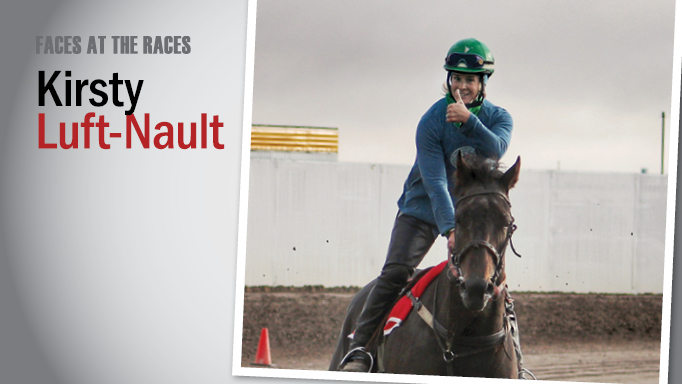Exercise riding racehorses is not a job to be taken lightly and no one knows that better than Kirsty Luft-Nault. Not only does she exercise ride, but Nault also instructs potential gallop riders and jockeys at Olds College in Alberta.
“It’s an every day job and early mornings. So it’s very physically demanding and you don’t get weekends off. When you’re a racetracker you are there every day,” she said.
Working in the horse racing industry since the late-‘90s, Nault is well versed on the daily ins and outs of track life. Starting as a groom for Dale Saunders, she then moved onto ponying and post parading before learning how to exercise ride at the track. Striving to always learn more, she took her trainers test around 2002 and has spent most of her career working out west.
Over the last three years, she has been working with students from Olds College to teach them various skills to gallop thoroughbreds at the track.
“[It’s] a little bit of everything. There are three of us that teach and we all teach different bits. But mostly for the riders how to exercise a racehorse, things you can do, tips and tricks, but a lot of it on the ground too. How to bandage and how to groom.”
The exercise rider and jockey program is a comprehensive training program that Nault explains starts within a schooling environment at Olds before moving to the track. “This year we were at the college for six weeks in the arena and then we came up to Northlands Racetrack. We are here on the track for six weeks and then the students go out into the industry.”
As with anything, when you move from theory to practicum, Nault acknowledges the transition from school to an actual working environment can sometimes be challenging for riders. “It is a huge — it’s a big jump from being indoors and four walls to moving outdoors. This year, specifically, we’ve had a really strong group of riders and they’ve all transitioned very well. It can be a bit overwhelming and you just have to boost their confidence and tell them it’s the same group of skills, you are just doing it in a different place.”
To ensure that transition is as smooth as possible, students have their initial training buddies tag along for the journey. “We bring the horses that they’ve been getting on, so they know the horses which is some familiarity, and we try to keep it as close to school as we can. You know they do the same things — they tack them the same and the only difference is they’re on the track and outside.”
Additionally, for the first several weeks at the track, the students ride with each other in a group of two or three before being integrated with the rest of the industry.
While the aim of the program is to teach students to exercise racehorses, Nault points out that students must also take care of their fitness before they can truly commit to the demands of working with thoroughbreds.
“The physical fitness I think is very underrated. When they are at the college they go to fitness every day and we ask them to come in fit. They always think they are fit and then are very surprised when they are not as fit, because it is way more physically demanding.”
Given her years of experience riding in the industry, Nault is well aware of how intense the demands of exercise riding can be for any riders. “If you watch somebody who is good at it, it doesn’t look like they are working at all, but they are. It is very physical and that is terribly underestimated.”
After six weeks of riding at the track and continuing to work on their own fitness, the students then prepare for phase three of the program. “Then they need to go into a barn which is their practicum, which is 60 rides I think before June 1st. They have to complete their 60 rides successfully and then they can go and apply for their exercise rider’s license,” said Nault who currently has six students in the program.
Without a doubt, Nault is proud of what her riders have accomplished so far and looks forward to seeing them take the next steps in their careers. Physical demands aside, she knows at the heart of her work that her riders not only have a drive to succeed, but also a passion and love for the sport.
“I think if you’re at the racetrack you have to love the horses, you are there because of the horses. I’m having fun showing people how to do it and bringing in new people, and introducing them to the industry. Especially with the college they are part of IFHA (the International Federation of Horse Racing Authorities) and with that they can travel and do all kinds of things. There are so many opportunities for new people coming into the program.”


